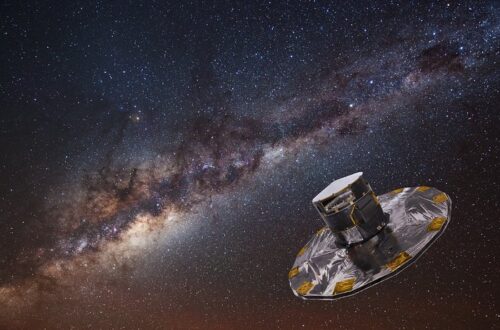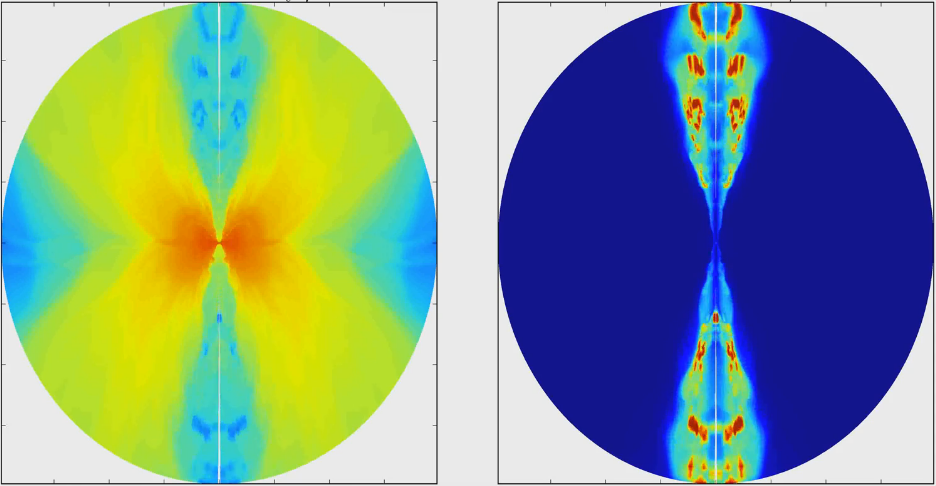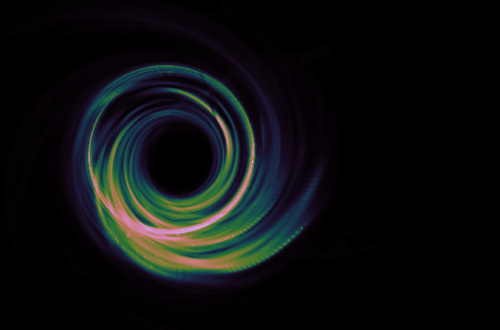Hi, I am Tom Russell, a Veni Research Fellow working with Sera’s group. My work mainly focuses on radio observations of accreting compact objects (mostly black hole and neutron star X-ray binaries, but even the occasional white dwarf) to see how the outflowing jet evolves over time. I then link the jet evolution to other processes that are occurring in the system to try to understand how jets are powered. At the moment we don’t really understand how these jets are launched, collimated, or even what they are composed of. It is important try to understand as much about this, because these systems output a huge amount of energy into the surroundings, which can influence the evolution of galaxies, shaping the Universe that we see today.
How can we ‘see’ a black hole?
A black hole is a region of space where matter has collapsed in on itself and the pull of gravity is so strong that light is not able to escape. Therefore, these objects cannot be directly observed and their presence must be inferred by the effect that they have on nearby material and stars. One of the most notable effects is accretion, where matter spirals towards the black hole in an accretion disk, where huge amounts of gravitational potential energy is liberated as X-ray radiation. Some of the infalling matter is diverted into powerful, focussed “jets” of energetic plasma that shoot out at close to the speed of light (Figure 1).
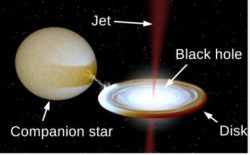
Figure 1: Cartoon of a black hole X-ray binary, showing matter fall in from the companion star (via the accretion disk) towards the black hole. Some of this transferred matter is diverted into powerful jets. (Image created using BinSim).
While there is a universal connection between the energy outflow and the accretion inflow (e.g. Fender et al., 2004), the mechanisms by which energy is channelled into the jets remains poorly understood. Therefore, we need to watch these systems over time to help understand how black holes redistribute energy.
X-ray binaries: test beds for studying jet launching
X-ray binaries (Figure 1) act as ideal laboratories to study how jets are launched from these systems, because they evolve on timescales of weeks and months (as opposed to AGN, which take millions of years). This rapid evolution allows us to study, in real time, the connection between the changing conditions in the accretion flow and the jets, to understand their connection. With well-established mass scaling relationships (e.g. Falcke et al. 2004), we can then use these insights to improve our understanding of jet formation on vastly greater temporal and physical scales in AGN.
Simultaneous multi-frequency observations are key!
On top of their rapid evolution, X-ray binaries emit radiation across a very broad range of the electromagnetic spectrum (Figure 2).
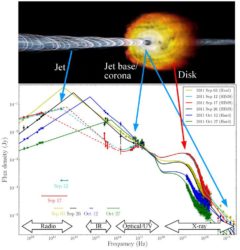
Figure 2: The multiwavelength evolution of an accreting stellar-mass black hole during outburst (Russell et al., 2014) mapped to the physical properties of the black hole system. Here, we see the contemporaneous evolution of the accretion inflow and the jet outflow, highlighting that time-resolved, multiwavelength observation are critical to the understanding these objects.
This means that to best understand how they evolve, we must observe these objects as simultaneously as possible over many different wavelengths. In the past, these observations were generally taken non-simultaneously and at only a couple of wavelengths. So, what I try to do is coordinate and take simultaneous (well, as simultaneous as possible) observations of these systems over many wavelengths to show their full broadband evolution, to show us how the jet and accretion flow are changing.
Reconstructing the picture to understand the physics
I then work with many members of Sera’s group (in particular Sera, Matteo and Chiara, but almost everyone to some extent) to reconstruct what is physically happening in these systems from what we see in these multiwavelength observations. Connecting the observations with the theoretical modelling is really important as both sides inform one another. It a nice relationship where the observations inform the models how to move, and the models inform the observers where to look and when. Working together, we are trying to better understand how these systems are able to launch jets and how much they influence their surroundings.
Understanding their influence
I have also been working with Tobi to try to observe jet-inflated lobes, or, in rare cases bubbles filled with hot plasma, which may be used as calorimeters understand the total power jets can carry (e.g. Gallo et al., 2005; Russell et al., 2007; Soria et al., 2010). This is a very difficult thing to do, but can allow us to understand how these jets are launched, and quantify how much energy the impart into their surroundings.

